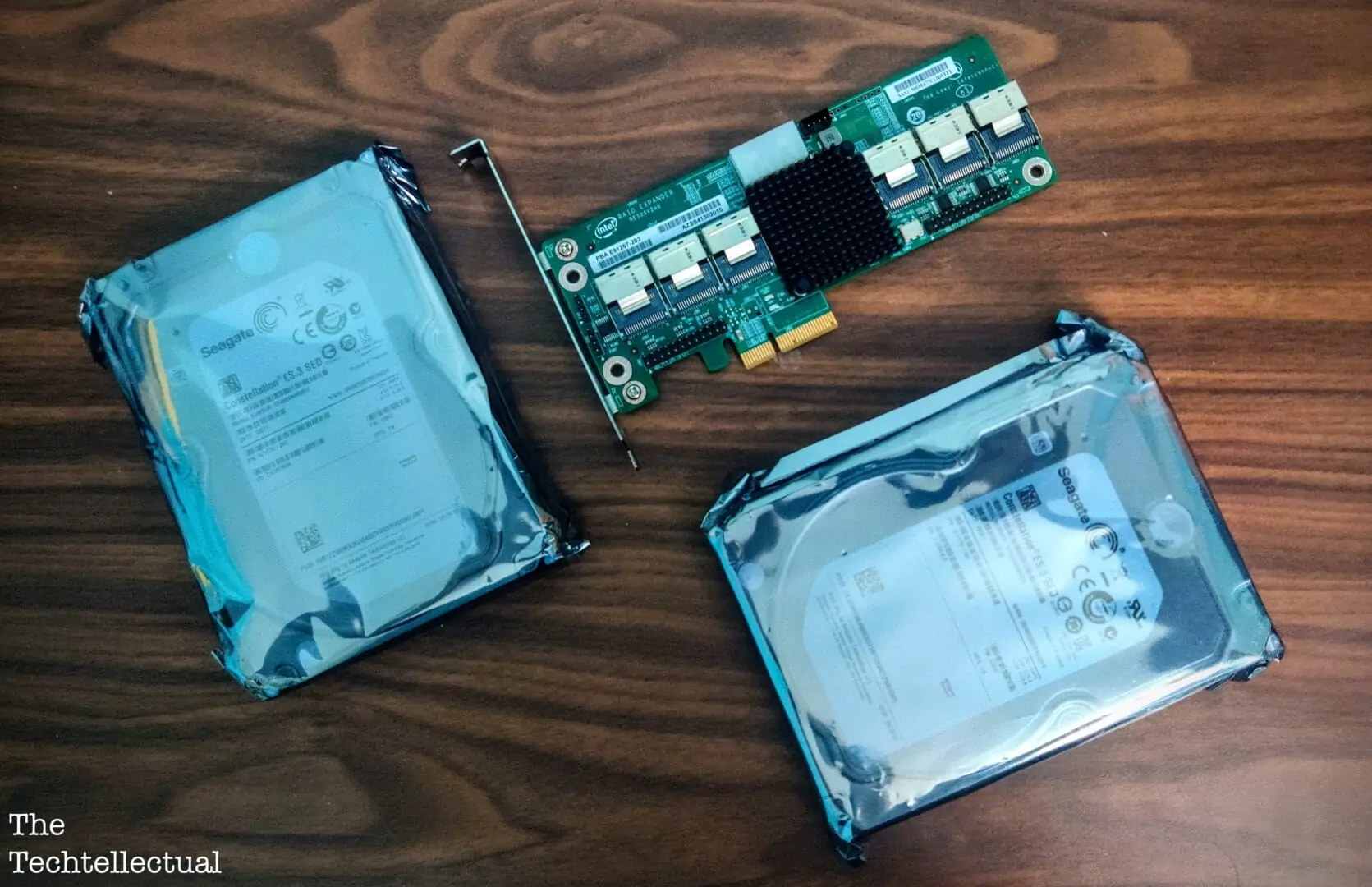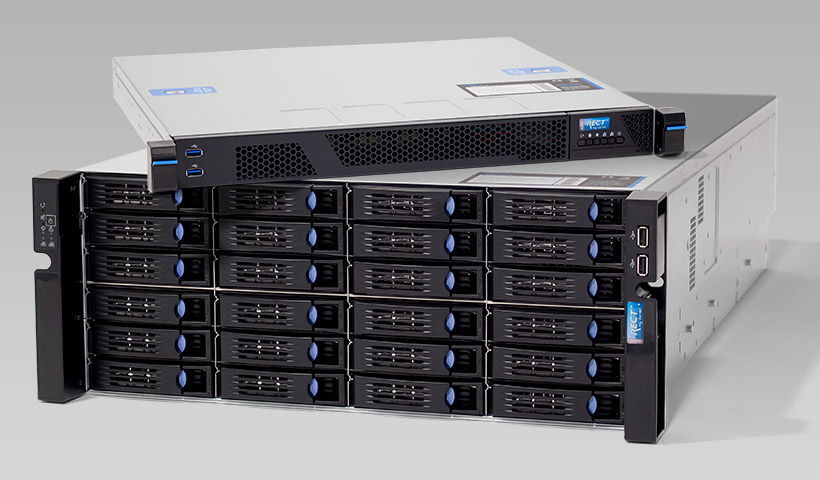You can often find cheap SAS (Serial Attached SCSI) drives online, thanks to their use in enterprise environments, where drives need to be upgraded periodically for better reliability. However, one downside to buying them is their lack of compatibility with consumer hardware.
It’s easy to mistake these drives for more common SATA (Serial ATA) drives as they share the same form factor and has a nearly identical connector, except for four additional pins on SAS drives. This allows SATA drives to connect with the SAS interface.
Unfortunately, a SAS drive cannot connect to the existing SATA ports on your motherboard. So, your only option is passing them through a universal interface like PCI Express or PCIe, found on all modern motherboards.

PCIe is one of the fastest ways to connect peripherals to your PC. It’s commonly used for connecting graphics cards and high-speed NVMe storage devices that need multiple lanes of high-bandwidth connectivity.
HBAs and RAID controllers
The most common way of connecting drives via PCIe is through an HBA. RAID controllers are HBAs that feature support for hardware-accelerated RAID, which most general consumer systems do not need. Software RAID performs better and is easier to use.
Most OEMs like Dell, HP, and IBM often use RAID controllers that are just HBAs flashed with custom firmware. If you get hold of such a RAID controller, we recommend you flash it to IT mode. RAID controllers tend to work with only specific models of hard disks belonging to the same OEM and have restrictions on the maximum number of drives that can be attached.
Remember that support for IT mode flashing depends on the controller, so it’s best to get one that’s already been flashed. If you bought an unflashed controller, you could find guides online by searching your RAID controller’s model no. Some controllers don’t support this, so consult this list before purchasing one.

SAS Expanders and DAS
SAS expanders can help split a single connection from an HBA into multiple ports for connecting even more HDDs. A SAS expander like Intel’s RES2SV240NC lets you add up to 20 additional drives for adding more drives. We have an article covering what SAS Expanders are in detail if you wish to learn more.
You will also need SAS cables to connect drives from the HBA to SAS expanders. SAS Expanders can also function without a motherboard but need an HBA to communicate with.
Direct Attached Storage or DAS works similarly but is used for external storage of drives if your current PC is limited in space and dramatically reduces clutter by using much fewer cables. Drives are placed into caddies and slide into their respective slots without wiring up each drive individually.

Choosing the right hardware
Most hard disks have speeds of 6 or 12 Gbps, which can let you theoretically connect up to 42 of them to a full-sized PCIe Gen 4 slot on your motherboard. For comparison, a modern GPU like Nvidia’s flagship 3090 supports the same number of lanes, while a high-speed Gen 4 NVMe SSD takes four.
There are sufficient lanes on current-generation motherboards to connect multiple HDDs directly to your PC. However, costs will pile up if you want each HDD to have access to the maximum SAS bandwidth of 6 Gbps.
For reference, a new Gen 4 9500-16i HBA will set you back $833 at current market prices. Adding a suitable 12Gbps SAS expander to the mix will add another $355 to your budget. We recommend this setup if you need the highest bandwidth per drive and can afford the costs.
The older generation used HBAs like this LSI 9211-8i is a cheaper solution suitable for home or small business use. You will lose out on a per-drive bandwidth, especially when adding multiple HDDs due to the slower PCIe 2.0 interface, but considering most use their drives in some form of RAID, this is an excellent solution for adding SAS drives to your PC.
Art of Server’s YouTube video compares the various models of HBAs available on the market and is worth a watch before investing in an HBA:
In conclusion, if you’re getting a good deal on used or refurbished SAS drives, then buying an HBA and a SAS Expander should help you easily connect these drives to your PC.
If you liked this article, then please feel free to share it. Be sure to ask any queries and mention any corrections in the comments. We’re looking forward to hearing more from you.


Comments
tx a lot Paul
You can buy a simple sas to sata adapter on Amazon for about 8 bucks + change and tax.
Unfortunately, Mike, the adapters you mention only connect a SATA drive to a SAS connector. The four additional pins on a SAS drive make it impossible to adapt to a standard SATA connector. You can read this article by Seagate explaining the same.
incorrect. sas drive to sata cable converters are available
Hey Tony, can you please share the specific SAS drive to SATA converter cable you mentioned? You may have mistaken them for a regular SATA drive to SAS cable. I did find one cable that claimed to do so , but in the description, it mentions only SAS to SAS or SATA Hybrid ( which again is just SAS) motherboard.
https://www.amazon.de/dp/B072XB4KJP?th=1
This would be one such connector. Physically it fits. Making my PC recognize the drive is another matter, and is what led me to this post to begin with. I’ll see if I can make it work or if it does indeed need a controller like this post suggests.
Hey Ivain,
I’ve done my best to get to the bottom of this. The motherboard mentioned is the Gigabyte GA-X79S-UP5 whose manual can ve downloaded from here. The manual shows SAS ports that use the physical SATA connector integrated into the Intel C606 chipset (the C600 series was the only chipset I know to support SAS natively). So the adapter is specifically made for motherboards with a C600 chipset that use SAS over the SATA port. The hard disk shown is a regular SATA hard disk which I personally own and know to have a SATA connector. You can check out it’s datasheet here. If you do not have a inbuilt SAS controller in your chipset, I would suggest looking into an HBA. Hope I was of help!
You’re most likely correct, I’ve since discovered elsewhere I’ll need a controller to properly use the disk. Ah well, making mistakes helps you learn.
Ivain, I did the same thing.. I bought two inexpensive 4GB SAS drives not knowing I couldn’t just use a SAS-to-SATA adapter and plug them into my Sabrent drive dock.
NO PC told david, or was that a server.
NO PC told you. so answers will wrong.
no there is no logic in that connector it is a passive adapter (plastic and wires)
to make any PC do SAS takes a real SAS controller.
and tony the OP posted, PC to SAS>
not sas to sata. see?
your are answering backwards path./
that is no cure for any SATA controller,
SATA controllers on all mobo do not do SAS.
and off topic. (sas to sata) is posted for the reverse of that.
He say PC to SAS.
99%^ off all PCs made the motor will never do SAS signalling.
old Intel chip sets do not run w10 up now. zero drivers.
the correct answer is and was buy a SAS controller with the correct cables.
LSI 9211 is dirt cheap and slow and best for testing a box off of used SAS 1TB drives.
if really serious buy the whole server, it comes with SAS.
At last, a clearly written article that explains how to connect a SAS drive.